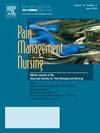Iranian Nurses’ Knowledge, Attitude, and Practice of Complementary Therapies for Pain Management
IF 1.6
4区 医学
Q2 NURSING
引用次数: 0
Abstract
Introduction
Complementary therapies (CTs) are being increasingly used by people with health issues and recommended by their health care providers. Although there are numerous studies available that address nurses' knowledge and attitudes regarding pain management, there are few that include the use of CTs by nurses in Iran. Therefore, this study was conducted in selected areas of Iran to assess nurses' knowledge, attitudes, and current practice regarding the use of CTs.
Methods
A cross–sectional study was conducted on a random sample of 850 nurses from various regions of Iran between 2020 and 2022. A questionnaire was used that consisted of seven items addressing demographic characteristics, 15 items to assess knowledge, 25 items to address attitude and 22 items to address the practice of CTs in the area of pain relief. Descriptive and inferential statistics were used to analyze the data.
Results
The participants’ mean age was 33.26 ± 7.24 years. Most nurses (89.9%) had not received formal education on CTs. However, 78.6% of nurses reported personal use of CTs, and 62.3% reported using or recommending it to their patients at least once. Regarding the knowledge of CTs, nurses scored 5.81 on a 15 points scale indicating a considerable gap in their knowledge of CTs. Regarding attitudes toward the specific therapies, nurses believed that massage is highly (46.4%) or moderately (31.6%) effective in pain relief. Regarding effectiveness, nurses ranked the following as the top four CTs: music therapy, humor, hydrotherapy, and use of cold / heat.
Conclusion
The nurses in this study scored low on knowledge of CTs, meaning that they knew little about CTs. However, they showed a favorable attitude toward CTs and a majority of them had a history of personal use, and recommending some types of CTs to their patients for pain relief. Therefore, it is crucial for nurse managers to provide opportunities to acquire knowledge of CTs. Moreover, nurse educators should advocate for updating nursing curricula to include CTs as an essential component of pain management education.
伊朗护士对辅助疗法治疗疼痛的认识、态度和实践。
导言:有健康问题的人越来越多地使用辅助疗法 (CT),并且他们的医疗服务提供者也推荐使用这种疗法。虽然有许多研究涉及护士对疼痛管理的知识和态度,但很少有研究涉及伊朗护士对 CT 的使用。因此,本研究在伊朗选定地区进行,以评估护士对 CT 使用的知识、态度和当前做法:2020 年至 2022 年期间,对来自伊朗不同地区的 850 名护士进行了随机抽样的横断面研究。调查问卷包括 7 个人口统计学特征项目、15 个知识评估项目、25 个态度项目和 22 个止痛 CT 实践项目。数据分析采用了描述性和推论性统计方法:参与者的平均年龄为 33.26±7.24 岁。大多数护士(89.9%)没有接受过正规的 CT 教育。不过,78.6% 的护士表示自己使用过 CT,62.3% 的护士表示至少向病人使用或推荐过一次 CT。关于 CT 的知识,护士们在 15 分制的量表中得了 5.81 分,这表明他们对 CT 的知识有相当大的差距。关于对特定疗法的态度,护士们认为按摩对缓解疼痛非常有效(46.4%)或中等有效(31.6%)。在效果方面,护士们将以下四种 CT 排在前四位:音乐疗法、幽默疗法、水疗法和使用冷/热疗法:本研究中的护士对 CT 的了解程度较低,这意味着她们对 CT 知之甚少。然而,她们对 CT 持赞成态度,其中大多数人都有亲自使用 CT 的经历,并向病人推荐过某些类型的 CT 来缓解疼痛。因此,护士长必须提供机会,让她们了解 CT 的相关知识。此外,护士教育者应倡导更新护理课程,将 CT 纳入疼痛管理教育的重要组成部分。
本文章由计算机程序翻译,如有差异,请以英文原文为准。
求助全文
约1分钟内获得全文
求助全文
来源期刊

Pain Management Nursing
医学-护理
CiteScore
3.00
自引率
5.90%
发文量
187
审稿时长
>12 weeks
期刊介绍:
This peer-reviewed journal offers a unique focus on the realm of pain management as it applies to nursing. Original and review articles from experts in the field offer key insights in the areas of clinical practice, advocacy, education, administration, and research. Additional features include practice guidelines and pharmacology updates.
 求助内容:
求助内容: 应助结果提醒方式:
应助结果提醒方式:


